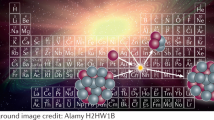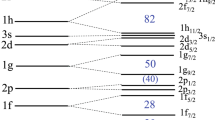Abstract
After a compact history of the PT, from Döbereiner’s triads to the theoretical predictions up to element 172, a number of particular issues is discussed: Why may Z = 172 be a limit for stable electron shells? What are the expected stability limits of the nuclear isotopes? When are formally empty atomic orbitals used in molecular electronic structures? What is ‘Secondary Periodicity’? When do the elements (Ir, Pt, Au), at the end of a bond, simulate (N, O, I), respectively? Some new suggestions for alternative PTs are commented upon. As a local connection, Johan Gadolin’s 1794 analysis of the Ytterby mineral is mentioned.
This chapter has been reproduced with permission from Ref. [1]. https://doi.org/10.1515/pac-2019-0801. Copyright 2019 IUPAC and De Gruyter.
A collection of invited papers based on presentations at “Mendeleev 150”: 4th International Conference on the Periodic Table endorsed by IUPAC, Saint Petersburg (Russia), 26–28 July 2019.
Access this chapter
Tax calculation will be finalised at checkout
Purchases are for personal use only
Similar content being viewed by others
Notes
- 1.
For more information on triads, see Chapter 3 of this volume—Ed.
- 2.
Other chapters in this volume treat in greater detail Beguyer de Chancourtois (5), Newlands (6), Meyer (8 and 9), Mendeleev (2), and the discovery of predicted elements (10)—Ed.
- 3.
Chapter 12 of this volume recounts the discovery of the noble gas elements—Ed.
- 4.
That is, Seaborg chose names for the actinides by analogy to the lanthanides’ names—Ed.
- 5.
The very compact size of the 5g shell would make these elements ‘superlanthanides’.
- 6.
See Chapter 16 of the present volume for further information on the Madelung rule and related topics—Ed.
References
Pyykkö P (2019) An essay on periodic tables. Pure Appl Chem 91:1959–1967
Kaji M (2002) D I Mendeleev’s concept of chemical elements and the principles of chemistry. Bull Hist Chem 27:4–16
Haba H (2019) A new period in superheavy-element hunting. Nature Chem 11:10–13
Pyykkö P (2016) Is the periodic table all right (“PT OK”)? Eur Phys J, Web of Conf 131:01001-1–01001-6
Pyykkö P (2011) A suggested periodic table up to Z ≤ 172, based on Dirac-Fock calculations on atoms and ions. Phys Chem Chem Phys 13:161–168
Aleksandrov IA, Plunien G, Shabaev VM (2019) Locally-constant field approximation in studies of electron-positron pair production in strong external fields. Phys Rev D 99:016020-1–016020-12
Pyykkö P (2012) The physics behind chemistry and the periodic table. Chem Rev 112:371–384
Indelicato P, Bieroń J, Jönsson P (2011) Are MCDF calculations 101% correct in the super-heavy elements range? Theor Chem Acc 129:495–505
Fricke B, Greiner W, Waber JT (1971) The continuation of the periodic table up to Z = 172. The chemistry of superheavy elements. Theor Chim Acta 21:235–260
Desclaux JP (1973) Relativistic Dirac-Fock expectation values for atoms with Z = 1 to Z = 120. At Data Nucl Data Tables 12:311–406
Eliav E, Fritzsche S, Kaldor U (2015) Electronic structure theory of the superheavy elements. Nucl Phys A 944:518–550
Porsev SG, Safronova MS, Safronova UI, Dzuba VA, Flambaum VV (2018) Nobelium energy levels and hyperfine-structure constants. Phys Rev A 98:052512-1–052512-6
Fermi E (1928) Eine statistische Methode zur Bestimmung einiger Eigenschaften des Atoms und ihre Anwendung auf die Theorie des periodischen Systems der Elemente. Z Phys 48:73–79 (an English abstract is available in (1928) Nature 121:502)
Dognon JP, Pyykkö P (2017) Chemistry of the 5g elements: relativistic calculations on hexafluorides. Angew Chem Int Ed 56:10132–10134
Gordin MD (2018) A Well-ordered thing: Dmitrii Mendeleev and the shadow of the periodic table, rev edn. Princeton University Press, Princeton, NJ
Scerri ER (2007) The periodic table: its story and its significance. Oxford University Press, Oxford
Eliav E, Kaldor U, Ishikawa Y, Pyykkö P (1996) Element 118: the first rare gas with an electron affinity. Phys Rev Lett 77:5350–5352
Wu X, Zhao L, Jin J, Pan S, Li W, Jin X, Wang G, Zhou M, Frenking G (2018) Observation of alkaline earth complexes M(CO)8 (M = Ca, Sr, or Ba) that mimic transition metals. Science 361:912–916
Biron EV (1915) Secondary periodicity. Zh Russk Fiz-Khim Obshch 47:964–988. See p 975
Pyykkö P (1979) Interpretation of secondary periodicity in the periodic table. J Chem Res Synop 380–381
Pyykkö P (1979) Dirac-Fock one-centre calculations part 8. The 1Σ states of ScH, YH, LaH, AcH, TmH, LuH and LrH. Phys Scr (Sweden) 20:647
Shchukarev SA (1977) New Understanding of DI Mendeleev’s system. 1. Periodicity in stratigraphy of atomic electron shells in the system and concept of kainosymmetry. (1977) J Gen Chem (USSR) 47:227–238 (Russian language version available at (1977) Zh Obshch Khim 47:246–259)
Imyanitov NS (2011) The periodic law. Formulations, equations, graphic representations. Russian J Inorg Chem 56:2183–2200
Sidgwick NV (1933) The covalent link in chemistry. Cornell University Press, Ithaca, NY, p 189
Pyykkö P (1988) Relativistic effects in structural chemistry. Chem Rev 88:563–594. See pp 578–580, 585. The later literature would require its own review
Jansen M (2008) The chemistry of gold as an anion. Chem Soc Rev 37:1824–1835
Pyykkö P (2002) Relativity, gold, closed-shell interactions, and CsAu∙NH3. Angew Chem Int Ed 41:3573–3578 (German language version available at (2002) Ang Chem 114:3723–3728)
Karpov A, Nuss J, Wedig U, Jansen M (2003) Cs2Pt: A platinide (–II) exhibiting complete charge separation. Angew Chem Int Ed 42:4818–4821 (German language version available at (2003) Angew Chem 115:4966–4969)
Patzschke M, Pyykkö P (2004) Darmstadtium carbonyl and carbide resemble platinum carbonyl and carbide. Chem Comm 1982–1983
Gagliardi L, Pyykkö P (2004) Theoretical search for very short metal-actinide bonds: NUIr and isoelectronic systems. Angew Chem Int Ed 43:1573–1576 (also available at (2004) Angew Chem 116:1599–1602)
Santos M, Marçalo J, Pires de Matos A, Gibson JK, Haire RG (2006) Actinide-transition metal heteronuclear ions and their oxides: {IrUO}+ as an analogue to uranyl. Eur J Inorg Chem 3346–3349
Giuliani SA, Matheson Z, Nazarewicz W, Olsen E, Reinhard PG, Sadhukhan J, Schuetrumpf B, Schunk N, Schwerdtfeger P (2019) Colloquium: Superheavy elements: Oganesson and beyond. Rev Mod Phys 91:011001-1–011001-12
Dong X, Oganov AR, Goncharov AF, Stavrou E, Lobanov S, Saleh G, Qian GR, Zhu Q, Gatti C, Deringer VL, Dronskowski RA, Zhou XF, Prakapenka VB, Konopkova Z, Popov IA, Boldyrev AI, Wang HT (2017) A stable compound of helium and sodium at high pressue. Nature Chem 9:440–445
Sato TK, Asai M, Borschevsky A, Stora T, Sato N, Kameya Y, Tsukada K, Düllmann ChE, Eberhardt K, Eliav E, Ichikawa S, Kaldor U, Kratz JV, Miyashita S, Nagame Y, Ooe K, Osa A, Renisch D, Runke J, Schädel M, Thörle-Pospiech P, Toyoshima A, Trautmann N (2015) Measurement of the first ionization potential of lawrencium, element 103. Nature 520:209–211
Xu WH, Pyykkö P (2016) Is the chemistry of lawrencium peculiar? Phys Chem Chem Phys 18:17351–17355
Abegg R (1904) Die Valenz und das periodische System. Versuch einer Theorie der Molekularverbindungen. Z Anorg Chem 39:330–380. See p 344
Xu WH, Jin X, Chen MH, Pyykkö P, Zhou MF, Li J (2012) Rare-earth monocarbonyls MCO: comprehensive infrared observations and a transparent theoretical interpretation for M = Sc; Y; La-Lu. Chem Sci 3:1548–1554
Scerri ER (2019) Five ideas in chemical education that must die. Found Chem 21:61–69
Madelung E (1936) Die mathematischen Hilfsmittel des Physikers, 3rd edn. Springer, Berlin, p 359
Janet C (2010) La classification hélicoidale des éléments chimiques. Impr. Dép. de l’Oise, Beauvais
Stewart PJ (2010) Charles Janet: unrecognized genius of the periodic system. Found Chem 12:5–15
Allen LC, Knight ET (2002) The Löwdin challenge: Origin of the n + ℓ, n (Madelung) rule for filling the orbital configurations of the periodic table. Int J Quantum Chem 90:80–88 (quote for the first version of the Madelung rule)
Sommerfeld A (1926) Electronic structure of the atom and the quantum theory. Mem Proc Manchester Lit Phil Soc 70:141–151
Fock VA (1936) Zur Theorie des Wasserstoffatoms. Z Phys 98:145–154
Ostrovsky VN (1981) Dynamic symmetry of atomic potential. J Phys B 14:4425–4439
Pašteka LF, Eliav E, Borschevsky A, Kaldor U, Schwerdtfeger P (2017) Relativistic coupled cluster calculations with variational quantum electrodynamics resolve the discrepancy between experiment and theory concerning the electron affinity and ionization potential of gold. Phys Rev Lett 118:023002-1–023002-5
Goeppert Mayer M (1941) Rare-earth and transuranic elements. Phys Rev 60:184–187
Sommerfeld A (1951) Atombau und Spektrallinien, vol 2: Wellenmechanischer Ergänzungsband (4th edn). F Vieweg & Sohn, Braunschweig, p 698. See Chapter 10, Section 4, equation 6
Gombás P (1956) Statistische Behandlung des Atoms. Handbuch der Physik 36:109–231. See p 181
Landau LD, Lifshitz EM (1956) Quantum mechanics. Non-relativistic theory (2nd edn). Pergamon Press, Oxford. See §70, 73
Iwanenko D, Larin S (1953) Theory of the periodic system of the elements. US Atomic Energy Commission, Technical Information Service, Washington DC (original article in Russian at (1953) Dokl Akad Nauk SSSR 88:45)
Klechkovskii VM (1951) Gruppy v posledovatel’nom zapolnenii elektronnykh konfiguratzii atomov [(n + ℓ) groups in successive filling of atomic electron configurations]. Dokl Akad Nauk SSSR 80:603–606
Klechkovskii VM (1962) Justification of the rule for successive filling on (n + ℓ) groups. Soviet Phys J Exp Theor Phys 14:334–335 (for the original Russian article, see (1962) Zh Eksp Teor Fiz 41:465–466)
Essén H (1982) Periodic table of the elements and the Thomas-Fermi atom. Int J Quantum Chem 21:717–726
Löwdin PO (1969) Some comments on the periodic system of the elements. Int J Quantum Chem Symp 3:331–334
Demkov YN, Ostrovsky VN (1971) Intrinsic symmetry of the Maxwell ‘fish-eye’ problem and the Fock group for the hydrogen atom. Soviet Phys J Exp Theor Phys 13:1083–1087 (for the original Russian article, see (1971) Zh Eksp Teor Fiz 60:2011–2018)
Demkov YN, Ostrovsky VN (1972) n + ℓ Filling rule in the periodic system and focusing potentials. Soviet Phys J Exp Theor Phys 35:66–69 (for the original Russian article, see (1972) Zh Eksp Teor Fiz 62:125–132)
Odabasi H (1973) Some evidence about the dynamical group SO (4, 2) symmetries of the periodic table of elements. Int J Quantum Chem Symp 7:23–33
Katriel J, Jørgensen CK (1982) Possible broken supersymmetry behind the periodic table. Chem Phys Lett 87:315–319
Kitagawara Y, Barut AO (1983) Period doubling in the n + l filling rule and dynamical symmetry of the Demkov-Ostrovsky atomic model. J Phys B 16:3305–3327
Novaro O (1989) Group theoretical aspects of the periodic table of the elements. J Mol Struct: THEOCHEM 199:103–118
Kibler M (1989) The periodic system of chemical elements: old and new developments. J Mol Struct: THEOCHEM 187:83–93
Ostrovsky VN (2001) What and how physics contributes to understanding the periodic law. Found Chem 3:145–181
Ostrovsky VN (2003) Physical explanation of the periodic table. Ann N Y Acad Sci 988:182–192
Wang SG, Schwarz WHE (2009) Icon of chemistry: the periodic system of chemical elements in the new century. Angew Chem Int Ed 48:3404–3415 (the original German article is available at (2009) Angew Chem 121:3456–3467)
Schwarz WHE, Rich RL (2010) Theoretical basis and correct explanation of the periodic system: review and update. J Chem Educ 87:435–443
Schwarz WHE (2010) The full story of the electron configurations of the transition elements. J Chem Educ 87:444–448
Leal W, Restrepo G (2019) Formal structure of periodic system of elements. Proc Roy Soc A 475:20180581-1–20180581-20
Gadolin J (1794) Undersökning av en svart tung stenart ifrån Ytterby stenbrott i Roslagen. Kungl Svenska Vetenskapsak Handl 15:137–155 (German version available at (1796) Crell’s Ann 313–329)
Pyykkö P, Orama O (1996) What did Johan Gadolin actually do? In: Evans CH (ed) Episodes from the history of the rare earth elements. Kluwer, Dordrecht, pp 1–12
Pyykkö P (2015) Magically magnetic gadolinium. Nature Chem 7:680–680
Author information
Authors and Affiliations
Corresponding author
Editor information
Editors and Affiliations
Rights and permissions
Copyright information
© 2021 The Author(s), under exclusive license to Springer Nature Switzerland AG
About this chapter
Cite this chapter
Pyykkö, P. (2021). An Essay on Periodic Tables. In: Giunta, C.J., Mainz, V.V., Girolami, G.S. (eds) 150 Years of the Periodic Table. Perspectives on the History of Chemistry. Springer, Cham. https://doi.org/10.1007/978-3-030-67910-1_17
Download citation
DOI: https://doi.org/10.1007/978-3-030-67910-1_17
Published:
Publisher Name: Springer, Cham
Print ISBN: 978-3-030-67909-5
Online ISBN: 978-3-030-67910-1
eBook Packages: Chemistry and Materials ScienceChemistry and Material Science (R0)




